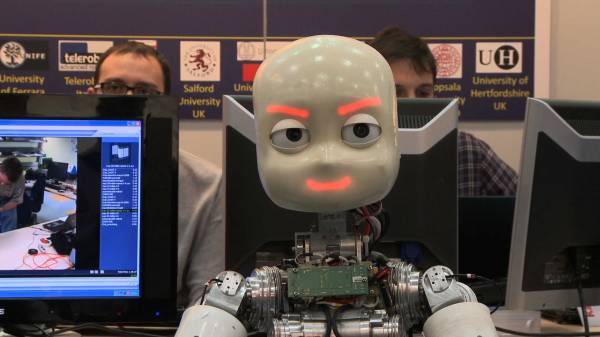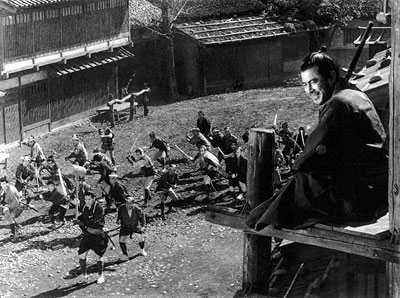
Cristofer Jean offers up some tempting and dangerous prophecies as the Forest Spirit in Ping Chong’s theatrical adaptation of Akira Kurosawa’s THRONE OF BLOOD (photo by Jenny Graham)
Next Wave Festival
BAM Howard Gilman Opera House
30 Lafayette Ave. between Ashland Pl. & St. Felix St.
November 10-13, $25-$60, 7:30
718-636-4100
www.bam.org
www.osfashland.org
Commissioned by BAM in conjunction with the Oregon Shakespeare Festival, Ping Chong’s THRONE OF BLOOD, adapted from Akira Kurosawa’s 1957 samurai reimagining of MACBETH, contains not a single line from the Bard’s tale of murderous ambition in Scotland. Kurosawa and his cowriters wrote the screenplay without referring to Shakespeare’s play, and Chong continues that tradition, working only from the movie script. Kevin Kenerly stars as Washizu, a warrior who quickly rises up the ranks after a mysterious meeting with a Forest Spirit (Cristofer Jean) who sees good things in his future, turning his wife, Lady Asaji (Ako), into a power-hungry villain. Chong incorporates elements of Noh, Kabuki, and Chinese opera into his production, which will be performed in English and features set design by Christopher Acebo, costumes by Stefani Mar, lighting by Darren McCroom, video and projections by Maya Ciarrocchi, and music and sound design by Todd Barton. The November 11 show will be preceded by an Artist Talk between Ping Chong and writer Ian Buruma at 6:00.
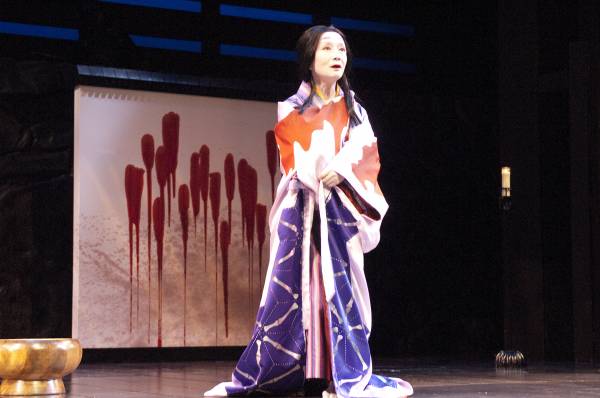
Lady Asaji has some dangerous ideas in Ping Chong’s theatrical adaptation of Akira Kurosawa’s THRONE OF BLOOD (photo by Jenny Graham)
(November 10 performance reviewed) Fans of Akira Kurosawa’s THRONE OF BLOOD are in for quite a treat with Ping Chong’s very entertaining theatrical adaptation, running at BAM through November 13. Chong, returning to the Next Wave Festival for the first time in fifteen years — he previously presented THE GAMES in 1984, THE ANGELS OF SWEDENBORG in 1986, and CHINOISERIE in 1995 — has interpreted Kurosawa’s reimagining of Shakespeare’s MACBETH for the stage, incorporating film, smoke effects, surround sound, and set changes that mimic the wipes Kurosawa favored. Set in feudal Japan, the story follows the swift rise of warriors Washizu (Kevin Kenerly) and Miki (Danforth Comins), as prophesied by an ancient white-haired spirit (Cristofer Jean) who inhabits the mysterious Spider Web Forest. When Washizu’s wife, Lady Asaji (Ako), hears about the prophecy, she hungers for the blood of everyone standing between her husband and the throne. Stefanni Mar’s costumes include wildly bizarre helmets and vestments that evoke the Star Wars films, while Maya Ciarrocchi’s projections are shown on a narrow horizontal screen that expands the stage, depicting the top of Spider Web Castle, the sky, or a pair of closed eyes ready to open at any moment. Ako delivers the show’s strongest performance, handling the Lady Macbeth role (sensationally played by Isuzu Yamada in the film) with finesse and just the right amount of evil, whether gliding ominously across the stage or standing in front of a Japanese screen dripping blood. Kenerly has the tough task of the Macbeth role so memorably played by Toshirō Mifune in the film and comes out relatively unscathed. However, many of the line readings by much of the cast leave something to be desired, with the actors too often hesitating at the wrong spots. (The production is primarily in English, with some Japanese, most of which is translated.) And Chong is a bit too worshipful of Kurosawa, including overt references in the dialogue to such films as STRAY DOG and THE LOWER DEPTHS that take the audience out of the play (which is, of course, the thing). But such are the ways of men. For those fans wondering how he pulls off the arrow-laden finale, Chong hits a bull’s-eye. Despite some silly, awkward moments, THRONE OF BLOOD is great fun, an adventurous evening of theater that will leave audiences craving more Akira Kurosawa — and more Ping Chong.
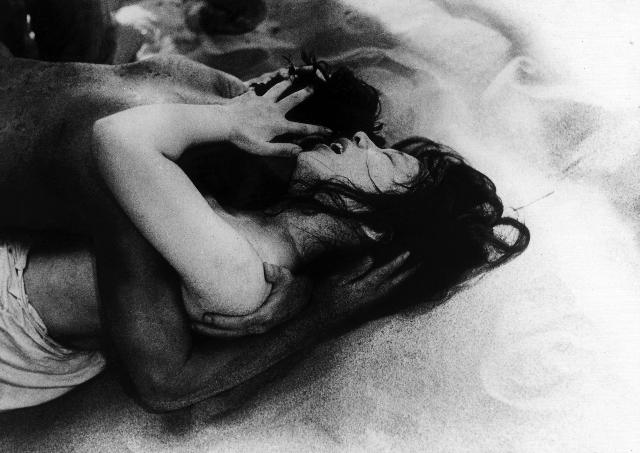
 Hiroshi Teshigahara’s Sisyphean tale, based on Kobo Abe’s marvelous novel, tells the story of an entomologist (Eiji Okada) out in the desert looking for insects when he comes upon a village of people living in the sand dunes — and he is unknowingly sucked into their world. Kyōko Kishida stars as the title character. See the movie — just wait till you get to the psychedelic head trip scene — but be sure to read the book as well; the scenes of the man trying to escape by climbing up the sand will feel oddly familiar to anyone who has ever been trapped in a seemingly inescapable situation. Teshigahara, who died in April 2001, adds surreal visual elements that make the film an unusually compelling though basically simple story. Abe also collaborated with Teshigahara on PITFALL (OTOSHIANA), THE FACE OF ANOTHER (TANIN NO KAO), and THE MAN WITHOUT A MAP (MOETSUKITA CHIZU). WOMAN IN THE DUNES is screening as part of Rabbitholestudio’s weekly Wednesday night film series, which features free admission and is now BYOB.
Hiroshi Teshigahara’s Sisyphean tale, based on Kobo Abe’s marvelous novel, tells the story of an entomologist (Eiji Okada) out in the desert looking for insects when he comes upon a village of people living in the sand dunes — and he is unknowingly sucked into their world. Kyōko Kishida stars as the title character. See the movie — just wait till you get to the psychedelic head trip scene — but be sure to read the book as well; the scenes of the man trying to escape by climbing up the sand will feel oddly familiar to anyone who has ever been trapped in a seemingly inescapable situation. Teshigahara, who died in April 2001, adds surreal visual elements that make the film an unusually compelling though basically simple story. Abe also collaborated with Teshigahara on PITFALL (OTOSHIANA), THE FACE OF ANOTHER (TANIN NO KAO), and THE MAN WITHOUT A MAP (MOETSUKITA CHIZU). WOMAN IN THE DUNES is screening as part of Rabbitholestudio’s weekly Wednesday night film series, which features free admission and is now BYOB.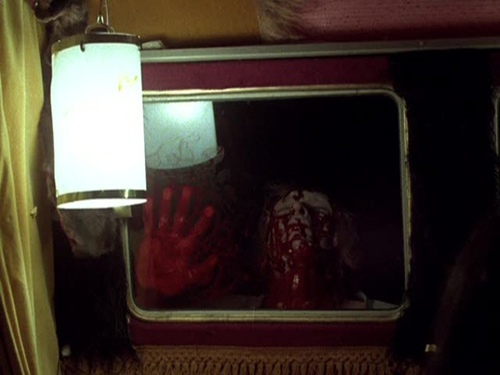
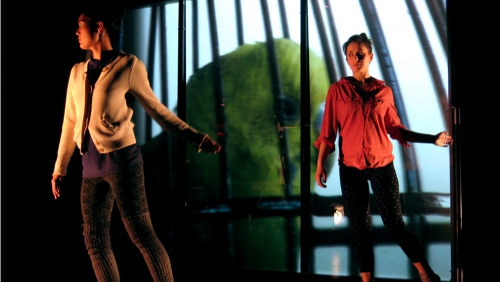
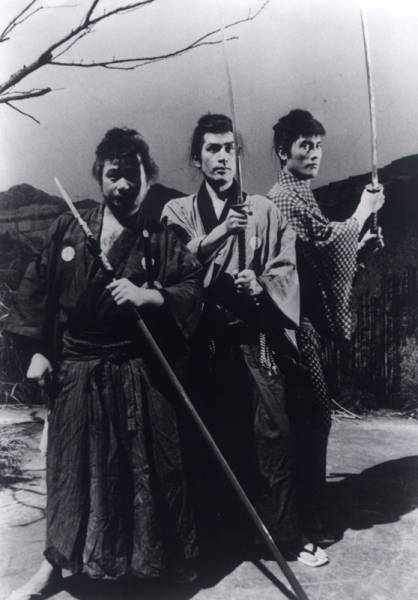
 Screening as part of Asia Society’s Japanese Cinema 1960s series, THREE OUTLAW SAMURAI stars Testsoro Tamba as Shiba, a wandering samurai who comes upon a town mired in chaos. The peasants have kidnapped the magistrate’s daughter (Miyuki Kuwano) to protest unfair taxation, but the magistrate has little time for them. Shiba is soon joined by Sakura (Isamu Nagato) and Kikyo (Mikihiro Hira) as they fight for what’s right. Director Hideo Gosha’s debut film, a classic Eastern Spaghetti Western, is more cerebral than many of its contemporaries, as it often opts for mental battles rather than swordfighting action. Sakura’s transition from a brash killer to a concerned potential lover is inspiring and heartbreaking, while Kikyo learns there’s more to being a samurai than wine and women. But don’t worry; Gosha makes sure we don’t get too bogged down in life lessons and sentimentalism. Tadashi Tsushima’s jazzy score is awesome. The series continues December 3 with Mikio Naruse’s YEARNING (1964) and December 10 with Kihachi Okamoto’s AGE OF ASSASSINS (1967) and Eiichi Kudo’s THE FORT OF DEATH (1969).
Screening as part of Asia Society’s Japanese Cinema 1960s series, THREE OUTLAW SAMURAI stars Testsoro Tamba as Shiba, a wandering samurai who comes upon a town mired in chaos. The peasants have kidnapped the magistrate’s daughter (Miyuki Kuwano) to protest unfair taxation, but the magistrate has little time for them. Shiba is soon joined by Sakura (Isamu Nagato) and Kikyo (Mikihiro Hira) as they fight for what’s right. Director Hideo Gosha’s debut film, a classic Eastern Spaghetti Western, is more cerebral than many of its contemporaries, as it often opts for mental battles rather than swordfighting action. Sakura’s transition from a brash killer to a concerned potential lover is inspiring and heartbreaking, while Kikyo learns there’s more to being a samurai than wine and women. But don’t worry; Gosha makes sure we don’t get too bogged down in life lessons and sentimentalism. Tadashi Tsushima’s jazzy score is awesome. The series continues December 3 with Mikio Naruse’s YEARNING (1964) and December 10 with Kihachi Okamoto’s AGE OF ASSASSINS (1967) and Eiichi Kudo’s THE FORT OF DEATH (1969).